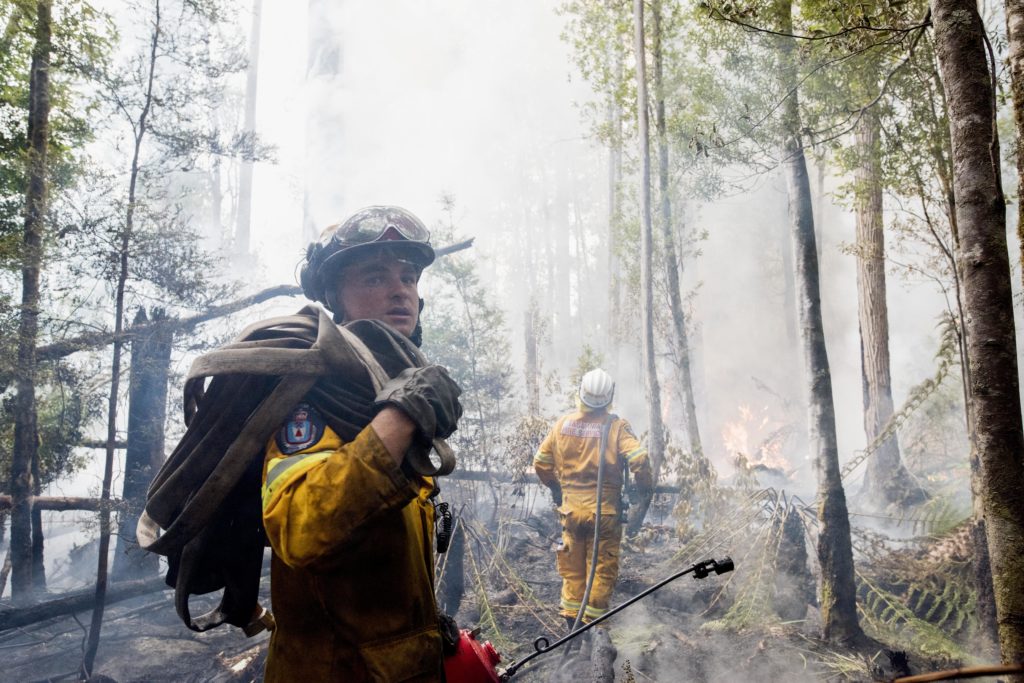BUSHFIRE experts and Tasmanian councils will today join together in a roundtable discussion to plan and prepare against worsening bushfires in the State.

Image credit: Warren Frey / Tasmania Fire Service
The virtual meeting, hosted by the Cities Power Partnership, will see more than 45 local and state government representatives, academics and community groups come together to develop new approaches that address the risks of longer, more intense bushfire seasons fuelled by climate change, following the Bushfire Royal Commission.
In 2018/19, 95,430 hectares of pristine Tasmanian Wilderness World Heritage Area was burned and 210,000 hectares of the state in total, as a result of climate-supercharged bushfires. Just three years earlier, in 2016, fire tore through ancient alpine ecosystems on the central plateau, killing trees that had stood for over a thousand years.
Attendees such as Huon Valley Council which were impacted by last year’s bushfires, will speak about the intensifying threat that continues to devastate local communities, native forests, wildlife and tourism in Tasmania.
Mayor Bec Enders of Huon Valley Council said the mammoth emergency response to last year’s bushfires was incredible for their small regional council, and the rebuilding efforts were still underway.
“Tasmanian communities need to understand that we’re living in a new era now, with intense bushfire seasons that start earlier and last longer, as a result of climate change,” said Mayor Enders.
“It’s important that councils across Tasmania work together to help our communities to understand, plan for, and respond to the increased bushfire threat, and we need more support from the state and federal government to do it.
Former Tasmania Fire Chief and Emergency Leaders for Climate Action spokesperson, Mike Brown said it’s important to have all of the information on hand when looking to better prepare and protect communities from future bushfire risk.
“We need to be clear – the tragic black summer fires were supercharged with the exceptionally dry landscape and extreme weather conditions. Fuel reduction is an important strategy but under extreme weather conditions, as a result of climate change, it’s not enough to protect our communities and the environment from high intensity bushfires,” said Mr Brown.
“There is an urgent need for more collaboration and conversation between fire authorities, landowners, land managers, planning authorities, local councils and communities to prepare for and respond to known future risk, while taking action on the root cause, worsening climate change.”
University of Tasmania’s Senior Lecturer in Climatology, Bec Harris warned local governments that the entire State was being affected by an increase in fire danger and risk.
“Some communities and regions such as the alpine areas and wilderness world heritage areas of Tasmania are more vulnerable or sensitive because, historically and very rarely, would they have been exposed to fire,” said Ms Harris.
“The increasing risk of catastrophic bushfires is dramatic and it cannot be underestimated. We’ve already seen how difficult it can be for a community to manage these risks without proper preparation, which was the case of Huon Valley and in Dunalley prior to that.
“If we’re serious about protecting our communities and world heritage forests, it’s imperative that all levels of government commit to swift and meaningful action to drive down Australia’s greenhouse gas emissions.”
COUNCILS TAKING PART
Burnie City
Central Highlands
Circular Head
Clarence City
George Town
Glamorgan Spring Bay
Glenorchy City
City of Hobart
Huon Valley
Kingborough Council
City of Launceston
Meander Valley
For more information contact Victoria Fratin, Media Advisor on 0431 314 047 or victoria@climatecouncil.org.au


